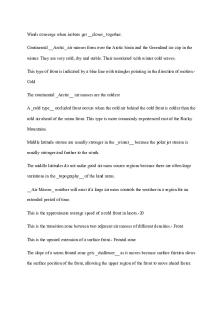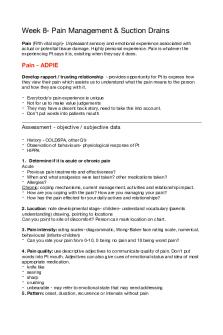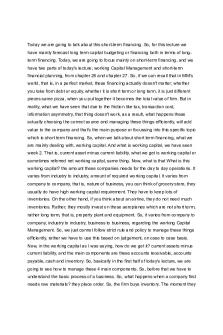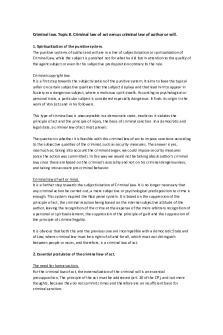Biology 101 Ch 8 - Lecture notes 8 PDF

| Title | Biology 101 Ch 8 - Lecture notes 8 |
|---|---|
| Course | Introduction to Biology A |
| Institution | University of Pennsylvania |
| Pages | 6 |
| File Size | 250.4 KB |
| File Type | |
| Total Downloads | 69 |
| Total Views | 171 |
Summary
Biology 101 Ch 8 - Lecture notes 8...
Description
BIOLOGY 101 Chapter 8: Photosynthesis Introduction Photosynthesis: biochemical process for building carbohydrates using energy from sunlight and CO2 taken from air. ● Carbohydrates used as starting points for synthesis of other molecules ● A means of storing energy that can be converted to ATP through cellular respiration.
8.1 Photosynthesis: An overview Photosynthesis - major entry point for energy into biological systems ● Source of all food, oxygen, heating, transportation. Photosynthesis is widely distributed. ● Occurs among prokaryotic as well as eukaryotic organisms Photosynthesis takes place almost everywhere sunlight is available to serve as a source of energy. ● In ocean, occurs in photic zone – extends about 100m deep ● Can occur in extreme environments – hot springs, desert crust Photosynthesis is a redox reaction. Carbs are synthesized from CO2 molecules during photosynthesis, but have more energy stored in their chemical bonds. ● Requires an input of energy from sunlight ● Redox reaction � the way through which sunlight energy goes into chemical bonds Redox: ● Reduction � molecules acquires electrons and gains energy ● Oxidation � molecules loses electrons and releases energy During photosynthesis, CO2 molecules are reduced to form high-energy carbohydrates � requires input of energy from ATP and electron donor (water) ● Water is oxidized, results in electrons, protons, and O2 ● Oxygen is formed in photosynthesis as by-product of water’s role in source of electrons � proven through experiments and molecular mass
Overall equation:
● Oxidation of water and reduction of CO2 is linked through series of reactions called photosynthetic electron transport chain. ● Process behinds with absorption of sunlight by protein pigment complexes. ● Absorbed sunlight provides energy that gives electrons through photosynthetic ETC ● Movement of electrons used to produce ATP and NADPH ● ATP and NAPH are energy sources used to synthesize carbohydrates using CO2 in process called Calvin cycle Quick Check 1 If you want to produce carbohydrates containing the heavy oxygen (18O)isotope, should you water your plants with H218O or inject C18O2 into the air? ● You should label the oxygen in CO2 (that is, inject C18O2) because the entire CO2molecule is used in synthesizing carbohydrates, whereas H2O donates only the electron needed for the reduction step of the Calvin cycle. The extraction of electrons from water releases O2 as a by-product. The photosynthetic electron transport chain takes place on specialized membranes. In ETC, electrons move within and between large protein complexes embedded in specialized membranes. ● In photosynthetic bacteria, ETC is located in membranes within cytoplasm or in some cases, directly in plasma membrane. ● In eukaryotes, photosynthesis takes place in chloroplasts in the thylakoid membrane (highly folded) � resemble flattened sacs, grouped into structures called grana that look like stacks of interlinked pancakes. ● Grana connected by membrane bridges that the thylakoid membrane encloses a single interconnected compartment called the lumen ● Region surrounding thylakoid membrane is the stroma ● Carbohydrate synthesis is in stroma.
● Although photosynthetic organisms are correctly described as autotrophs because they can form carbohydrates from CO2 they also require constant supply of ATP. ● Although ATP produced within chloroplasts, only carbs are exported from chloroplasts to cytosol � why cells also have mitochondria to break down carbs to ATP ● Cellular respiration � key feature shared in heterotrophic and photosynthetic organisms
8.2 The Calvin Cycle The Calvin cycle consists of 15 chemical reactions that synthesize carbohydrates from CO2 with 3 main steps: 1. Carboxylation – CO2 added to 5 carbon molecule 2. Reduction 3. Regeneration – of 5 carbon molecule needed for carboxylation The incorporation of CO2 is catalyzed by the enzyme rubisco. ● First step: carbon dioxide added to 5 carbon sugar, ribulose 1,5-bisphosphate (RuBP) ● This step is catalyzed by rubisco ● An enzyme that adds CO2 to another molecule – called carboxylase ● Before rubisco can act as carboxylase, RuBP and CO2 must diffuse into its active site ● Reaction occurs spontaneously, no input of energy required ● Product: 6 carbon compound that immediately breaks into two molecules of 3phosphoglycerate (3-PGA) – first stable products of Calvin cycle
NADPH is the reducing agent of the Calvin cycle. Rubisco – responsible for the addition of carbon atoms needed for the formation of carbohydrates, but by itself does not increase amount of energy stored within newly formed bonds ● For energy increase to happen � carbon compounds formed by rubisco need to be reduced ● NADPH is the reducing agent used in the Calvin cycle � transfers the electrons that allow carbohydrates to be synthesized from carbon dioxide ● NADPH can move freely in stroma � powerful reducing agent, but only under catalysis of specific enzyme � highly controlled Reduction of 3-PGA has two steps: 1. ATP donates phosphate group to 3-PGA 2. NADPH transfers 2 electrons plus one proton to phosphorylated compound which releases one phosphate group Because 2 molecules of 3-PGA are formed each time rubisco incorporates one molecule of CO2, two ATP and two NADP are required for one molecule of CO2. ● NADPH provides most of the energy incorporated into carbohydrate molecules. ● Result: 3 carbon carbohydrate molecules (triose phosphates) � principal form in which carbs are exported from chloroplast � larger sugars made from triose phosphates in cytoplasm ● Most of the triose phosphates used to regenerate RuBP � every 6 produced, 1 can be withdrawn from Calvin cycle The regeneration of RuBP requires ATP. 15 chemical reactions make up Calvin cycle – 12 occur in the last step � regeneration of RuBP. ● Large number of reactions is needed to rearrange five 3-carbon triose phosphate molecules to three 5 –carbon RuBP molecules. ● Uses ATP Quick Check 2 The Calvin cycle requires both ATP and NADPH. Which of these molecules provides the major input of energy needed to synthesize carbohydrates? ● NADPH The steps of the carbon cycle were determined using radioactive carbon dioxide. Melvin Calvin identified carbon compounds produced during photosynthesis – supplied radioactively labeled to alga Chlorella and plunged cells into boiling alcohol, stopping all enzymatic reactions. The carbon compounds produced during photosynthesis were thus radioactively labeled and could be identified by radioactivity
Carbohydrates are stored in the form of starch. If carbohydrates accumulate in a cell, they would cause water to enter the cell by osmosis, potentially causing damage. ● Starch molecules not soluble � does not lead to osmosis
8.3 Capturing Sunlight into Chemical Forms Chlorophyll is the major entry point for light energy in photosynthesis. ● Visible light is the portion of the electromagnetic spectrum apparent to our eyes – range from 400 nm to 700 nm ● Approximately 40% of sun’s energy that reaches Earth’s surface is in this range ● Pigments are molecules that absorb some wavelengths of visible light ● Chlorophyll – major photosynthetic pigment ● Alternating single and double bonds in head region explains why chlorophyll is so efficient at absorbing
● Protein-pigment complexes are referred to as photosystems, and are the functional structural units that absorb light energy and use it to drive electron transport ● Accessory pigments – pigments other than chlorophyll in photosystems ex carotenoids
Photosystems use light energy to drive the photosynthetic electron transport chain. ● Visible light absorbed by chlorophyll � one of its electrons elevated to higher energy state ● Absorbed light energy rapidly released � electron goes back to ground state ● Most of energy converted to heat, some released as light (fluorescence) ● Chlorophyll molecules with intact chloroplast, energy can be transferred to adjacent chlorophyll molecule
● Most chlorophyll molecules in thylakoid serve as antenna ● Reaction center – where light energy is converted to chemical energy ● Antenna chlorophyll allow photosynthetic ETC to operate efficiently Reaction center chlorophylls have configuration distinct from antenna ones. ● When electron is passed on, reaction center reduced, and adjacent electron acceptor is reduced. Starts redox reaction chain that forms NADPH ● Reaction center needs replacement electrons � come from water The photosynthetic electron transport chain connects two photosystems o Takes a great amount of energy to pull electrons from water � solution: use 2 photosystems arranged in series
8.4 Challenges to Photosynthetic Efficiency...
Similar Free PDFs

Biology Notes Ch 8
- 5 Pages

Marketing CH 8 - Lecture notes 8
- 5 Pages

CH 8/ Lecture 8 ANSWERS
- 13 Pages

8 - Lecture notes 8
- 21 Pages

8 - Lecture notes 8
- 21 Pages

Ch 8- Social Notes - ch 8
- 2 Pages

8 Midwifery - Lecture notes 8
- 3 Pages

Taxation 8 - Lecture notes 8
- 2 Pages

Week 8 - Lecture notes 8
- 6 Pages

Dox 8 - Lecture notes 8
- 21 Pages

Lesson 8 - Lecture notes 8
- 2 Pages

Assignment 8 - Lecture notes 8
- 4 Pages

Week 8 - Lecture notes 8
- 23 Pages
Popular Institutions
- Tinajero National High School - Annex
- Politeknik Caltex Riau
- Yokohama City University
- SGT University
- University of Al-Qadisiyah
- Divine Word College of Vigan
- Techniek College Rotterdam
- Universidade de Santiago
- Universiti Teknologi MARA Cawangan Johor Kampus Pasir Gudang
- Poltekkes Kemenkes Yogyakarta
- Baguio City National High School
- Colegio san marcos
- preparatoria uno
- Centro de Bachillerato Tecnológico Industrial y de Servicios No. 107
- Dalian Maritime University
- Quang Trung Secondary School
- Colegio Tecnológico en Informática
- Corporación Regional de Educación Superior
- Grupo CEDVA
- Dar Al Uloom University
- Centro de Estudios Preuniversitarios de la Universidad Nacional de Ingeniería
- 上智大学
- Aakash International School, Nuna Majara
- San Felipe Neri Catholic School
- Kang Chiao International School - New Taipei City
- Misamis Occidental National High School
- Institución Educativa Escuela Normal Juan Ladrilleros
- Kolehiyo ng Pantukan
- Batanes State College
- Instituto Continental
- Sekolah Menengah Kejuruan Kesehatan Kaltara (Tarakan)
- Colegio de La Inmaculada Concepcion - Cebu


